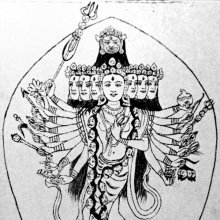Vidyujjvalakarali, Vidyujjvālākarālī, Vidyujjvala-karali: 1 definition
Introduction:
Vidyujjvalakarali means something in Buddhism, Pali. If you want to know the exact meaning, history, etymology or English translation of this term then check out the descriptions on this page. Add your comment or reference to a book if you want to contribute to this summary article.
Images (photo gallery)
In Buddhism
Tibetan Buddhism (Vajrayana or tantric Buddhism)
Source: archive.org: The Indian Buddhist IconographyVidyujjvālākarālī (विद्युज्ज्वालाकराली) refers to a variety of Ekajaṭā: one of the female emanations of Akṣobhya, as mentioned in the 5th-century Sādhanamālā (a collection of sādhana texts that contain detailed instructions for rituals).—Her colour is blue; her Āsana is the pratyālīḍha; her Vāhana is Indra, Brahmā, Viṣṇu and Śiva; she has twelve faces and twenty-four arms.—Ekajaṭā is one of the most powerful goddesses in the Vajrayāna pantheon. [...] Ekajaṭā may have several forms with blue colour, and she bears the image of her sire Akṣobhya on her crown in all cases. All her forms have been described previously along with the other emanations of the Dhyāni Buddha Akṣobhya including the terrible form which goes by the name of Vidyujjvālākarālī of blue colour, with twelve faces and twenty-four arms.
Vidyujjvālākarālī is said to have originated from the sweat of Buddha. This form of Ekajaṭā, with twelve faces and twenty-four arms, is rarely met with in sculptures either in stone or in bronze.
Vidyujjvālākarālī’s symbols in the left hand are:
- khaḍga,
- vajra,
- cakra,
- jewel,
- aṅkuśa,
- arrow,
- dart,
- mudgara,
- mūṣala,
- kartri,
- ḍamaru,
- rosary.
Vidyujjvālākarālī’s symbols in the right hand are:
- bow,
- noos,
- tarjanī,
- banner,
- mace,
- truśūla,
- wine-glass,
- utpala,
- bell,
- paraśu,
- brahmaśiras,
- kapāla.
The Dhyāna (meditation instructions) of Vidyujjvālākarālī described in the Sādhanamālā as follows:—
“The worshipper should conceive himself as (Vidyujjvālākarālī) who has twelve faces, deep blue colour and twenty-four arms, she tramples upon the, four Māras (Brahmā, Viṣṇu, Śiva and Indra), stands on white skulls in the pratyālīḍha attitude, is terrible like the Fire of Destruction, has a wide open mouth from which comes the sounds of ‘hā’ ‘hā’. She has protruding tongue, is wrathful, has eyes round and moving, and her forehead is distorted owing to the frequent contortions of the brows. She is more awe-inspiring than Awe itself, and her head is decorated with a garland of skulls; she is decked in ornaments of snake, and is endowed with the six auspicious symbols; her first face is of deep blue colour and the five faces to the right are white, yellow, green, red and smoky in colour; the five faces to the left are of red, white, yellow, green and whitish red colour. The face on the topis of the colour of smoke, distorted and displays anger.
All her faces look terrible with bare fangs and three eyes; her brown hair rise upwards in the shape of a flame; she is short and has a protruding belly. Her breasts are full and heaving; she is clad in tiger-skin, and carries in her twelve right hands, 1. the sword, 2. the thunderbolt, 3. the discus, 4. the jewel, 5. the elephant-goad, 6. the arrow, 7. the dart, 8. the hammer, 9. the pestle, 10. the saw, 11. the drum and 12. the rosary; and in her twelve left hands she has 1. the bow, 2. the noose, 3. the raised index finger, 4. the flag, 5. the mace, 6. the trident, 7. the wine-glass, 8. the blue lotus, 9. the bell, 10. the axe, 11. the severed head of Brahmā, 12. and the skull.
In an extremely happy mood she rides a corpse, is youthful, appears resplendent with terrible laugh, wears a jaṭāmukutā, which is brown and fiery and which bears the image of Akṣobhya on it.”

Tibetan Buddhism includes schools such as Nyingma, Kadampa, Kagyu and Gelug. Their primary canon of literature is divided in two broad categories: The Kangyur, which consists of Buddha’s words, and the Tengyur, which includes commentaries from various sources. Esotericism and tantra techniques (vajrayāna) are collected indepently.
See also (Relevant definitions)
Partial matches: Karali, Vidyujjvala.
Full-text: Amritalocana, Amritamukhi, Prasannatara, Ekajata.
Relevant text
Search found 1 books and stories containing Vidyujjvalakarali, Vidyujjvālākarālī, Vidyujjvala-karali, Vidyujjvālā-karālī; (plurals include: Vidyujjvalakaralis, Vidyujjvālākarālīs, karalis, karālīs). You can also click to the full overview containing English textual excerpts. Below are direct links for the most relevant articles:
The Indian Buddhist Iconography (by Benoytosh Bhattachacharyya)
